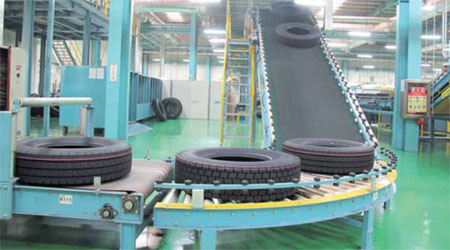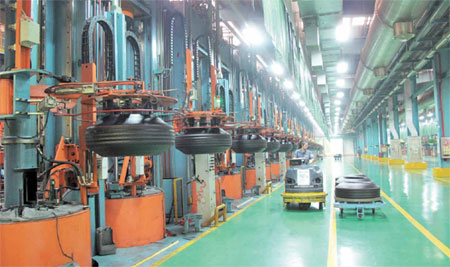New business link forged from historic bond
Updated: 2013-11-29 10:32
By Zheng Yangpeng (China Daily Europe)
|
|||||||||||
Sino-Korean industrial park at forefront of continuing revitalization of China's great western municipality, the mega city of Chongqing
In Nov 1945, when Kim Gu, president of the provisional government of the Republic of Korea, finished six years of exile in Chongqing and left for home, he expressed his gratitude to the Chinese government in an open letter for its "generous" financial support, especially when China itself was also experiencing extreme hardship.
That wartime friendship has not been forgotten by South Koreans, as many still choose to pay a visit to the site of their exiled government when they visit China.
Now, as Chongqing, the largest city in China by population, opens itself to the world in pursuit of economic progress, memories of those dark days are frequently cited as an important emotional link between the two East Asian countries, which have a tradition of building business ties on personal relationships.
South Koreans are not only guided by old alliances, but are also lured by the exciting business opportunities in western China, which is still relatively underdeveloped compared with the eastern coastal region.
In September 2011, the two governments signed an agreement to launch the Sino-Korean Industrial Park in Chongqing Liangjiang (Two Rivers) New Area, the third national development area approved directly by the State Council after Shanghai's Pudong New Area and the Binhai New Area in Tianjin. It is also the third industrial park jointly built with a foreign country, after ones in Suzhou and Tianjin, both in collaboration with the Singapore government. This gave South Korea a foothold in a strategically important growth engine in China.
"In the 1980s, watch Shenzhen; in the 1990s, watch Pudong; in the 2000s, watch Binhai; in this new decade, watch Liangjiang", the catchphrase repeatedly propounded here, crystallizes a feeling of pride and expectation, that for too long, the inland mega city, a temporary capital during World War II, had been resting on former glories and envying the prosperity of once lesser-known cities, such as Shenzhen and Suzhou, brought about by their proximity to the international market. Now, finally, it is Chongqing's time.
In the past decade, the "go west" campaign launched by the central government changed the landscape of the less-developed western provinces - highways, railways, bridges and airports have been built on a massive scale; GDP growth has been faster than their eastern counterparts for the past six years; and people's incomes have grown considerably.
Chongqing has more reasons to be optimistic. In 2010, a 1,200-square-kilometer area across from the north bank of the city's central Yuzhong peninsula was pinpointed as a "New Area", a national-level pilot zone to test new policies, introduce foreign investment and drive future growth.
As China opens up more, expanding from the east coast to areas along major rivers and borders, Chongqing is well positioned as the largest city on the upper stretch of the Yangtze River, China's golden waterway.
It is also the starting point of a strategic inter-continental railway line, crossing north through the Xinjiang Uygur autonomous region, Kazakhstan and Russia to Duisburg in Germany. After the route opened, Chongqing suddenly found itself at the forefront of opening up to the European market.
"We do not regard ourselves as an inland city. We consider Chongqing as a yanbian (along the border) city," says Hao Ming, deputy director-general of the administrative committee of Liangjiang New Area, which houses the Sino-Korean Industrial Park.
"Foreign companies do not regard the western area only as a production base. Rather, they deem it as the gateway to a 300-million population market."
Hao's views are shared by many Korean businessmen working in Chongqing, attracted by what they see as a huge and largely untapped market.
"It is definitely the center of the western region," says Chang Maeng-Keun, factory director and vice-president of Hankook Tire Group, which is investing $954 million (705 million euros) in the Sino-Korean Industrial Park.
Completed this June, the first phase of the project has a production capacity of 2,400 truck tires a day. When the second phase is finished in early 2015, the company expects to produce another 16,000 car tires a day.
Hao says the fact the investment was made before there was a whole-car production factory in the city, underlines Hankook's eagerness to access the market. Though Chongqing is an auto parts and motorcycle manufacturing hub, less than 30 percent of Hankook's tires are sold to western China.
As most of Hankook's products are either transported by trucks or ships to other markets, sound infrastructure was another reason why Hankook settled on Chongqing, Chang says.
The Chongqing plant is Hankook's third in China, after Huai'an in Jiangsu province and Jiaxing in Zhejiang. Chang has overseen both these factories for more than 10 years. He says Chongqing's electricity and gas prices are 30 percent cheaper than for the eastern plants, and he claims that although the company pays the same wages for Chongqing workers, they are more diligent and efficient.
However, it isn't all smooth going. When Hankook decided to open the factory in Chongqing, China's GDP growth was still above 10 percent. This year it has dropped to 7.6 percent, and tire sales are currently lower than expected. China's labor costs have also risen significantly since the factory was built, which forced the company to increase investment in automatic equipment.

Xing Jun, a team leader of Chongqing Yuhan Lithium Ion Battery Materials Co, a wholly-owned subsidiary of SK Group, also says the key reason for his company investing $100 million in the Sino-Korean Industrial Park is the potentially huge market of the western region.
That belief persuaded him and SK Group heads to persist even in 2012, when the fallout of former city chief Bo Xilai's corruption case was at its worst and unnerved many investors.
"What we care about is not the ups and downs of a single person, but the fundamentals of Chongqing, and the fundamentals of Chongqing remain intact," Xing says.
His company will start production in the first quarter of 2014 producing 2,400 metric tons of battery materials a year. SK Group is also in a joint venture building a chemical plant and semiconductor plant in suburban Chongqing.
According to Chongqing government data, by the end of last year, 107 South Korean enterprises had registered in the municipality with an implemented investment of $316 million. Fortune Global 500 companies such as Hyundai Motor Company and Pohang Iron and Steel Co Ltd are negotiating with the Chongqing government over major deals.
Closer business ties have also resulted in increased demand for travel with the number of direct flights between Chongqing and Seoul increasing from two to four a week.
However, officials of the Liangjiang New Area say attracting foreign investment was not its main focus. They are more concerned with fostering industry conglomeration.
"We are not attracting business for the sake of it," says Hao Ming. "We want to share emerging development benefits with foreign investors. We don't care that much about the specific number of landed businesses. We care about cultivating a function for the park."
That function, he says, lies in being multifunctional, in creating different areas for different uses. For example, the Jiangbeizui area is designed to be a financial district just like Shanghai's Lujiazui, and the bonded zone is designed to be a huge logistics and processing center.
The Sino-Korean Industrial Park is less a physical park and more a concept, he says. The official vision is that different kinds of Korean enterprises will be located in different functional areas.
"Only when the function is cultivated, can the best practitioners come and gain recognition, just as performers do on the stage. And we mean to attract the top industries and technologies," Hao says.
zhengyangpeng@chinadaily.com.cn
|
Hankook Tire Group has invested $954 million in the Sino-Korean Industrial Park in Chongqing Liangjiang New Area. The company now has a production capacity of 2,400 truck tires a day and is expected to produce another 16,000 car tires a day in early 2015. Photos by Ji Jin / China Daily |

(China Daily European Weekly 11/29/2013 page16)
Today's Top News
Cameron to arrive with big delegation
China launches moon rover
Honor Cairo Declaration
34th high-speed railway starts
Testing time for China's tea growers
8 dead in police helicopter crash onto Glasgow pub
Xi stresses fight against HIV
Premier's trips bear fruit
Hot Topics
Lunar probe , China growth forecasts, Emission rules get tougher, China seen through 'colored lens', International board,
Editor's Picks

|

|

|

|

|

|





